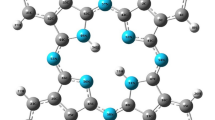Abstract
In this article, we employed density functional theory calculation methods to determine the relationship between the chemical hardness (η), intermolecular chemical hardness (η DA), and nucleophilicity (N) chemical reactivity descriptors, as well as the energy of the occupied frontier orbitals (E a1g), and the electrocatalytic activity of different metallophthalocyanines [MPc’s with M=Cr(II), Mn(II), Fe(II), Co(I), Ni(II), and Cu(II)] for the oxygen reduction reaction. Our results suggest that η DA, N, and E a1g are appropriate parameters to estimate the electrocatalytic activity. On the other hand, the type of the metallic center determines the strength of the oxygen-binding energy, where a strong electronic interaction promotes the efficient electro-reduction of the dioxygen molecule, which is observed experimentally as a high catalytic activity.




Similar content being viewed by others
References
Baerends EJ, Ellis DE, Ros P (1973) Chem Phys 2:41. doi:10.1016/0301-0104(73)80059-X
Barraclough CG, Martin RL, Mitra S, Sherwood RC (1970) J Chem Phys 53:1638. doi:10.1063/1.1674236
Cardenas-Jiron GI, Zagal JH (2000) J Electroanal Chem 489:96–100. doi:10.1016/S0022-0728(00)00209-6
Cardenas-Jiron GI, Zagal JH (2001) J Electroanal Chem 497(1–2):55–60. doi:10.1016/S0022-0728(00)00434-4
Chermette H (1999) J Comput Chem 20:129. doi:10.1002/(SICI)1096-987X(19990115)20:1<129:AID-JCC13>3.0.CO;2-A
Contreras R, Andres J, Safont VS, Campodonico P, Santos JG (2003) J Phys Chem A 107(29):5588–5593. doi:10.1021/jp0302865
de Diesbach H, von der Weid W (1927) Helv Chim Acta 10:886. doi:10.1002/hlca.192701001110
Domingo LR, Chamorro E, Pérez P (2008) J Org Chem 73:4615. doi:10.1021/jo800572a
Geerlings P, De Proft F, Martin JML (1996) In recent developments and applications of modern density functional theory. In: Seminario JM (ed) Theoretical and computational chemistry, vol 4. Elsevier, Amsterdam, p 773. ISBN 9780444824042
Geerlings P, De Proft F, Langenaeker W (2003) Chem Rev 103:1793–1873. doi:10.1021/cr990029p
Geraldo G, Linares C, Chen Y, Ureta-Zañartu S, Zagal JH (2002) Electrochem Commun 4:182. doi:10.1016/S1388-2481(01)00300-9
Hoffmann R, Chen M, Thorn D (1977) Inorg Chem 16:503. doi:10.1021/ic50169a001
Jaramillo P, Pérez P, Contreras R, Tiznado W, Fuentealba P (2006) J Phys Chem A 110:8181–8187. doi:10.1021/jp057351q
Jaramillo P, Domingo LR, Chamorro E, Pérez P (2008) J Mol Struct THOECHEM 865:68. doi:10.1016/j.theochem.2008.06.022
Kirner JF, Dow W, Scheidt WR (1976) Inorg Chem 15:1685. doi:10.1021/ic50161a042
Koch W, Holthausen MC (2000) A chemist’s guide to density functional theory. Wiley-VCH, Weinheim. ISBN 978-3-527-30372-4
Koopmans T (1933) Physica 1:104–113. doi:10.1016/S0031-8914(34)90011-2
Labarta A, Molins E, Viñas X, Tejada J, Caubet A, Alvarez S (1984) J Chem Phys 80:444. doi:10.1063/1.446469
Lever ABP (1965) J Chem Soc 1821. doi:10.1039/JR9650001821
Leznoff CC, Lever ABP (1993) Phthalocyanines properties and applications, vol 3, Chap 1. Wiley-VCH, Weinheim, Germany
Liao MS, Scheiner S (2001) J Chem Phys 114:9780. doi:10.1063/1.1367374
Linares C, Geraldo D, Paez M, Zagal JH (2003) J Solid State Electrochem 7:626. doi:10.1590/S0103-50532008000400016
Liu K, Lei Y, Wang G (2013) J Chem Phys 139:204306. doi:10.1063/1.4832696
Manassen J, Bar-Ilan A (1970) J Cat 17(1):86. doi:10.1016/0021-9517(70)90076-X
Miyoshi H (1974) Bull Chem Soc Jpn 47:561. doi:10.1246/bcsj.47.561
Parr RG, Pearson RG (1983) J Am Chem Soc 105:7512–7516. doi:10.1021/ja00364a005
Parr RG, Yang W (1989) Density functional theory of atoms and molecules. Oxford University Press, Clarendon Press, New York, Oxford. ISBN 978-0195092769
Perdew JP, Chevary JA, Vosko SH, Jackson KA, Pederson MR, Singh DJ, Fiolhais C (1992) Phys Rev B 46:6671. doi:10.1103/PhysRevB.46.6671
Pérez P, Domingo LR, Duque-Noreña M, Chamorro E (2009) J Mol Struct THOECHEM 895:86. doi:10.1016/j.theochem.2008.10.014
Randin J-P (1974) Electrochim Acta 19:83. doi:10.1016/0013-4686(74)85060-7
Savy M, Andro P, Bernard C, Magner G (1973) Electrochim Acta 18(2):191. doi:10.1016/0013-4686(73)80011-8
SCM (2002) ADF2002.01, Vrije Universiteit, Amsterdam, The Netherlands. http://www.scm.com. Accessed 01 June 2017
Senff H, Klemm W (1939) J Prakt Chem 154:73. doi:10.1002/prac.19391540303
Shi Z, Zhang J (2007) J Phys Chem C 111:7084. doi:10.1021/jp0671749
Sorokin AB (2013) Chem Rev 113:8152. doi:10.1021/cr4000072
Stillman MJ, Thomson AJ (1974) J Chem Soc Faraday Trans 70:790. doi:10.1039/F29747000790
Sun S, Jiang N, Xia D (2011) J Phys Chem C 115:9511. doi:10.1021/jp101036j
Tsuda M, Dy ES, Kasai H (2005) J Chem Phys 122:244719. doi:10.1063/1.1947187
Van Lenthe E, Baerends EJ (2003) J Comput Chem 24(9):1142. doi:10.1002/jcc.10255
Versluis L, Ziegler T (1988) J Chem Phys 88:322. doi:10.1063/1.454603
Vosko SH, Wilk L, Nusair M (1980) Can J Phys 58:1200. doi:10.1139/p80-159
Wiesener K, Ohms D, Neumann V, Franke R (1989) Mater Chem Phys 22(3–4):457–475. doi:10.1016/0254-0584(89)90010-2
Williams GA, Figgis BN, Mason R, Mason SA, Fielding PE (1980) J Chem Soc Dalton 1688. doi:10.1039/DT9800001688
Wu W, Kerridge A, Harker AH, Fisher A (2008) J Phys Rev B77:184403. doi:10.1103/PhysRevB.77.184403
Zagal JH (1992) Coord Chem Rev 119:89. doi:10.1016/0010-8545(92)80031-L
Zagal JH (2003) Macrocycles. In: Vielstich W, Gasteiger HA, Lamm A (eds) Hardbook of fuel cells-fundamentals, technology, and applications, chapter 37. Wiley, New York. ISBN 978-0-471-49926-8
Zagal JH, Cardenas-Jiron GI (2000) J Electroanal Chem 489(1–2):96–100. doi:10.1016/S0022-0728(00)00209-6
Zagal JH, Koper MTM (2016) Angew Chem Int Ed 55(47):14510. doi:10.1002/anie.201604311
Zagal JH, Gulppi M, Isaacs M, Cardenas-Jirón G, Aguirre MJ (1998) Electrochim Acta 44:1349. doi:10.1016/S0013-4686(98)00257-6
Zagal JH, Griveau S, Silva JF, Nyokong T, Bedioui F (2010) Coord Chem Rev 254(23–24):2755. doi:10.1016/j.ccr.2010.05.001
Zagal JH, Recio FJ, Gutierrez CA, Zuñiga C, Páez MA, Caro CA (2014) Electrochem Commun 41:24–26. doi:10.1016/j.elecom.2014.01.009
Zerner M, Gouterman M (1966) Theor Chim Acta 4:44. doi:10.1007/BF00526010
Acknowledgements
The authors thank the financial support of FONDECYT Grants 1131123, 1150629, 3150438 and INICIATIVA CIENTIFICA MILENIO Grant RC120001.
Author information
Authors and Affiliations
Corresponding author
Rights and permissions
About this article
Cite this article
Linares-Flores, C., Arratia-Pérez, R. & MacLeod Carey, D. Chemical reactivity descriptors evaluation for determining catalytic activity, redox potential, and oxygen binding of metallophthalocyanines. Chem. Pap. 71, 2185–2194 (2017). https://doi.org/10.1007/s11696-017-0212-x
Received:
Accepted:
Published:
Issue Date:
DOI: https://doi.org/10.1007/s11696-017-0212-x




